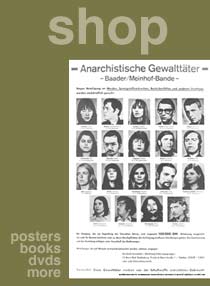pre-1968 > 1968 > 1969 > 1970 > 1971 > 1972 > 1973 > 1974 > 1975 > 1976 > 1977 > post-1977
.jpg) |
2 June, 1967, Berlin. Benno Ohnesorg, a young student pacifist and new father, is shot and killed by police while attending a protest against a visit by the Shah of Iran. The radical movement gains a martyr.
|
pre-1968
24 May 1967, Berlin
Two days after a devastating fire sweeps through a Brussels department store, members of Kommune I, a radical commune, pass out a leaflet at Berlin's Free University which jokingly suggests that a good way to bring the Marxist Revolution home is to deliberately burn down department stores. Kommune I members Fritz Teufel and Rainer Langhans were arrested and charged with inciting arson.
2 June 1967, Berlin
The Shah of Iran pays an official visit to Berlin. Thousands of students take to the streets to protest the Shah's brutally repressive regime. Students seem to be protesting every week--everything, from the war in Vietnam, to the Grand Coalition between the two major German political parties, to university policies, were used as excuses to march. It is all quite a lot of fun.
Noted journalist Ulrike Meinhof certainly enjoys attending the protests. She is the former editor of the leftist magazine konkret (founded and still published by her soon-to-be ex-husband Klaus Rainer Röhl) and she has recently begun appearing on television political panel shows. Though she has her spoons in many pots, she still writes a twice-monthly column for konkret. Prior to the Shah's arrival she wrote a biting critique in konkret of the out-of-touch nature of the Shah and his wife. But Meinhof can't make the 2 June Berlin protest; she is busy shopping for furniture for her new Hamburg home.
A young troublemaker named Andreas Baader also misses the 2 June protest. He is cooling his heels in a Traunstein jail, serving time for stealing a motorcycle.
A reed-thin some-time student, Gudrun Ensslin, is able to make the protest. She too has been a regular fixture at many of the Berlin protests; in the coming months she often will show up pushing her young baby son along in a stroller. For the Shah protest, fortunately, she leaves her two-week old baby Felix with her estranged husband, Bernward Vesper.
In the early evening thousands of protesters begin lining up behind police barricades across the street from the Opera House where the Shah is about to attend a performance. A few protesters lob paint-filled balloons; but nothing comes close to the Shah, who slips into the Opera House without even noticing the protesters.
As the people begin to disperse, the cops surprise them. The police utilize a new technique that they have developed for terrorizing crowds; they call it "The Liver-Sausage Method." Like a stuffed liver sausage, the crowd of demonstrators is stuffed long and tight on the sidewalk between the barricades and buildings. The cops form a wedge, and rush the middle of the "sausage." The demonstrators naturally rush sideways--the sausage exploding at its ends--and into the flailing truncheons of hundreds more waiting police. Pandemonium rules. At one point the police grab one protester whom they believe to be a ringleader. Detective Sgt. Karl-Heinz Kurras points his gun at the protester's head, and the guns goes off; possibly accidentally. Young Benno Ohnesorg, attending his first protest, is dead. The growing leftist movement gains a martyr.
Protesters stream away from the scene, in shock that the protest had turned deadly. Many students head towards the office of the SDS (a prominent student organization) on the Ku-Damm; Ensslin is among them. Inside Ensslin screams: "This fascist state means to kill us all! We must organize resistance. Violence is the only way to answer violence. This is the Auschwitz Generation, and there's no arguing with them!"
 |
3 June 1967, Berlin - Gudrun Ensslin, far right, participates in a protest following the police shooting of a student the night before.
|
3, June, Berlin
A ban on all protest signs and banners is put in effect on the streets of Berlin. A student, Peter Homann, comes up with an ingenious prank to get around the ban; dress up eight people in tee-shirts, each with a single giant letter painted on the front and back. When lined up side-by-side the group's tee-shirts read A-L-B-E-R-T-Z-! -- referring to Berlin Mayor Heinrich Albertz -- and when the group turns around in unison, their backs read A-B-T-R-E-T-E-N -- which means "resign." Photos appear across West Germany the next day -- on the far right, with a giant exclamation point on her chest, is Ensslin. Despite Homann's ingenuity, all eight protesters are arrested.
Mid-Summer, Berlin
Baader meets Ensslin at a gathering. They fall in love immediately.


